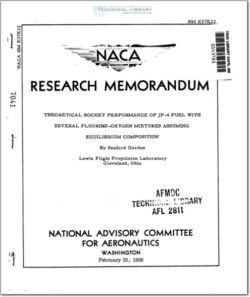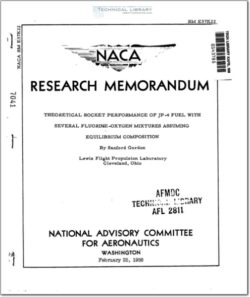NACA-RM-E57k22

- Version
- 142 Downloads
- 2.87 MB File Size
- 1 File Count
- December 4, 2015 Create Date
- December 4, 2015 Last Updated
National Advisory Committee for Aeronautics, Research Memorandum - Theoretical Rocket Performance of JP-4 Fuel with Several Fluorine-Oxygen Mixtures Assuming Equilibrium Composition

Theoretical rocket performance for equilibrium composition during
expansion was calculated for JP—4 fuel with several fluorine-oxygen mix—
tures for a range of pressure ratios and oxidant-fuel ratios. The pa-
rameters included are specific impulse, combustionrchamber temperature,
nozzle-exit temperature, molecular weight, characteristic velocity, coef-
ficient of thrust, ratio of nozzle-exit area to throat area, specific
heat at constant pressure, isentropic exponent, viscosity, thermal con-
ductivity, and equilibrium gas compositions. A correlation is given for
the effect of chamber pressure on several of the parameters.
The maximum value of specific impulse for a chamber pressure of 600
pounds per square inch absolute (40.827 atm) and an exit pressure of 1
atmosphere is 525.7 for 70.57 percent fluorine in the oxidant as compared
with 284.9 and 505.1 for 100 percent oxygen and 100 percent fluorine,
respectively.
Mixtures of liquid fluorine and liquid oxygen as oxidants with
hydrocarbons as fuel have been considered in recent years for possible
high-energy rocket propellants. Mixtures of fluorine and oxygen exist
that give higher performance with hydrocarbons then either 100 percent
oxygen or fluorine because fluorine burns preferentially with hydrogen,
and oxygen with carbon.
Theoretical calculations (ref. 1) show that maximum specific impulse
can be obtained when the oxidant contains about 70 percent fluorine.
Often, however, theoretical performance data are needed for comparison
with experimental data obtained for various percentages of fluorine in
the oxidant. Calculations were therefore made at the NACA Lewis labora-
tory during 1955 and 1956 in order to provide performance data for O to
100 percent fluorine in the oxidant. Performance data based on frozen
composition during expansion are given in reference 2.
| File | Action |
|---|---|
| naca-rm-e57k22.pdf | Download |

Comment On This Post